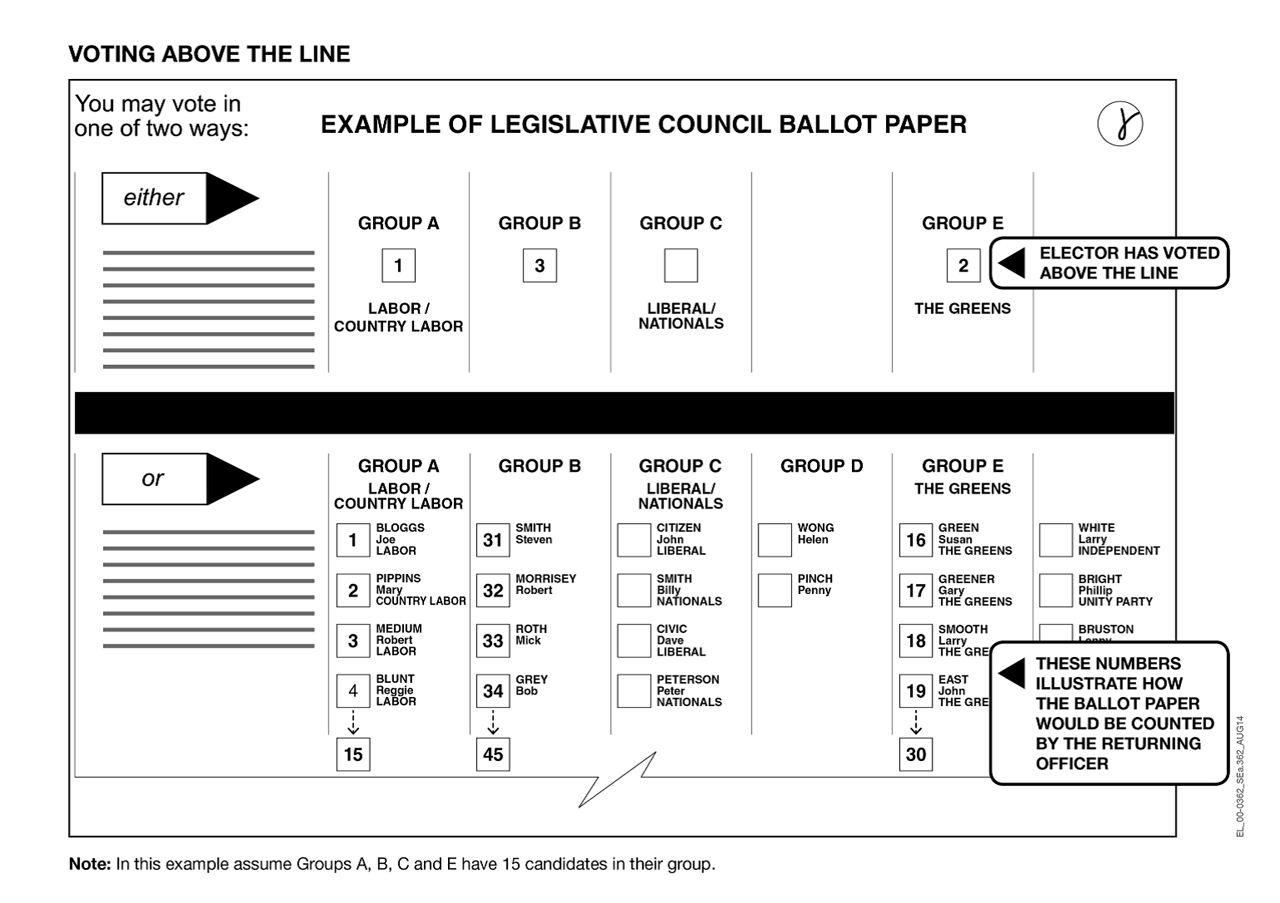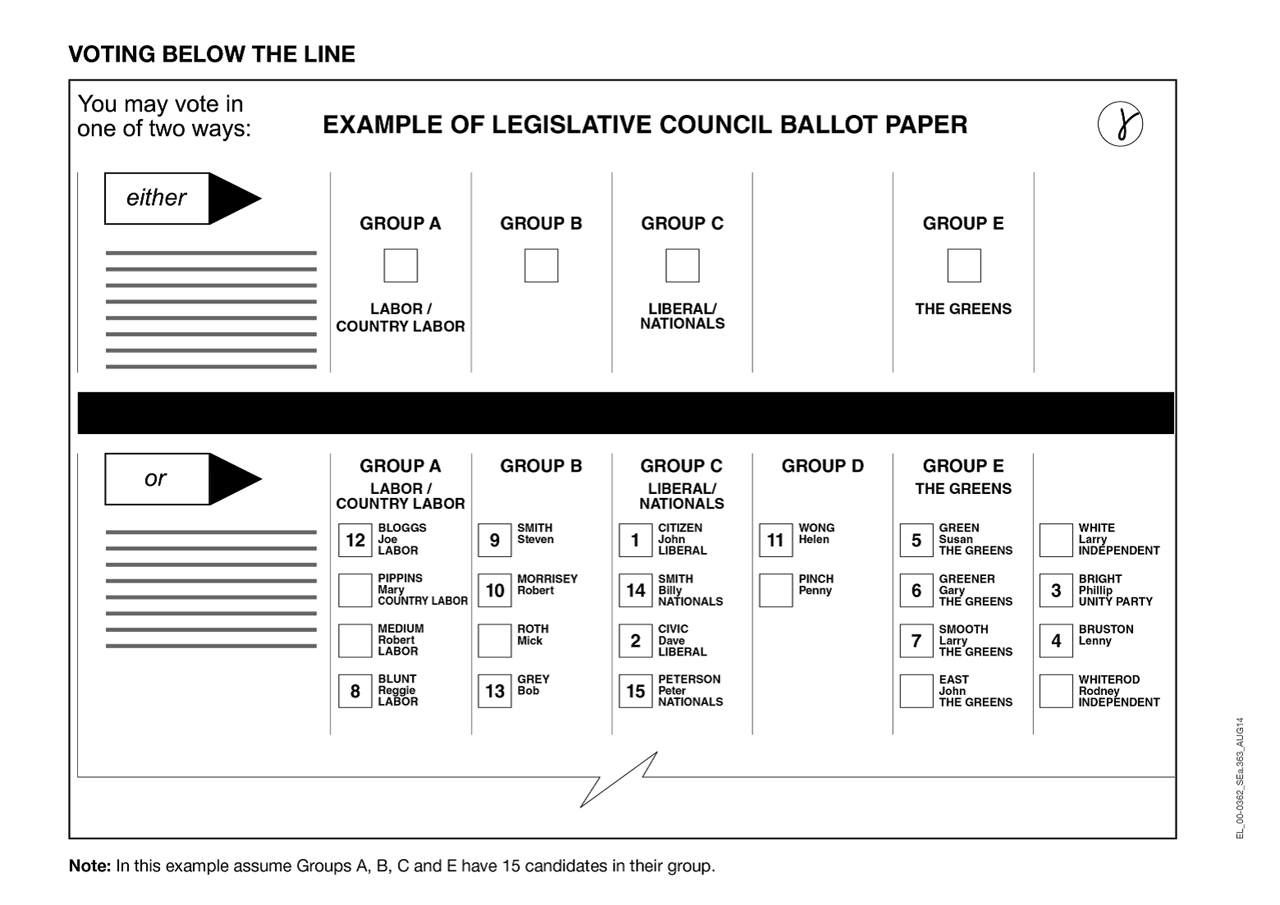NSW STATE ELECTION RESULTS 2015
Saturday 28 March 2015
LEGISLATIVE COUNCIL: COUNT EXPLANATION
Legislative Council Voting
To cast a formal vote the elector may choose to vote either ‘Above The Line’ or ‘Below The Line’ on the Legislative Council ballot paper.
Voting Above The Line
If an elector chooses to vote 'Above The Line' (ATL), they must place the number '1' in the Group Voting Square for the group of their choice.
The elector has the 'option' to show further preferences by placing the number '2' in the Group Voting Square next to their second choice group, the number '3' in the Group Voting Square next to their third choice group and so on. The elector may number as many or as few Group Voting Squares beyond their first choice group as they wish.
In the example Legislative Council ballot paper below, assume Groups A, B, C and E each have 15 candidates in their group. The elector has voted 'Above The Line'. The numbers 'Below The Line' illustrate how this ballot paper would be counted by the Returning Officer.
| Above The Line Vote | Counted by the Returning Officer |
| 1 for Group A ‘Labor/Country Labor’ | ballot paper is counted 1 to 15 in descending order for the 15 candidates in Group A |
| 2 for Group E ‘The Greens’ | ballot paper is counted 16 to 30 in descending order for the 15 candidates in Group E |
| 3 for Group B | ballot paper is counted 31 to 45 in descending order for the 15 candidates in Group B |

Voting Below The Line
If an elector chooses to vote 'Below The Line' (BTL), they must vote for at least 15 candidates by placing the numbers '1' to '15' in the squares next to the candidates in the order of their choice.
The elector has the 'option' to show further preferences starting with the number '16' and so on. They may number as many or as few squares beyond their 15th choice candidate as they wish.
When voting 'Below The Line', the elector is not required to vote for all candidates in a group before voting for candidates in another group.

Ballot papers marked above and below the line
If a ballot paper is marked both 'Above The Line' and 'Below The Line', and both sections are formal, the 'Below The Line' section takes precedence. If one section (above or below the line) is formal and the other informal, the formal section takes precedence.
Under no circumstances should an elector be instructed to vote both above and below the line on their ballot paper.
Formality of Ballot Papers
If the elector does not vote in the manner described then the vote may be informal and not counted. However, the Returning Officer may still count the vote under savings provisions contained in the Act, eg: a tick or a “X” may be counted as a first preference mark in certain circumstances ‘Above The Line’.
It is illegal however, for electoral material (how- to-vote cards) to be distributed directing electors to show a tick or “X” on the How-to-vote ballot paper.
Legislative Council Sort and Counts
Legislative Council ballot papers will undergo the following:
- initial 1st preference sort (manual sort);
- check count of all preferences (data entry process); and
- Distribution of Preferences to determine elected candidates (conducted in the NSWEC computer count system).
Initial Sort
The initial sort of Legislative Council ballot papers will be to the following categories:
- 1st preference ‘Above The Line’ for each group;
- Blank ( where the elector has chosen not to mark their ballot paper); and
- Others.
‘Others’ will include any ballot paper:
- marked ‘Below The Line’ only;
- marked both ‘Above and Below The Line’;
- any ballot paper that is not a 1st preference ‘Above The Line’.
It is important to note that many of the ballot papers in the ‘Others’ pile will be formal and will be identified as such during the check count (data entry).
The initial sort of Legislative Council ballot papers will not take into consideration the formality of the ballot papers. Formality will be determined at the check count (data entry) conducted at the Legislative Council Count Centre (LCCC).
Check Count (Data Entry)
Once the Legislative Council ballot papers have undergone the initial sort they will be packaged and sent to the Legislative Council Counting Centre (LCCC) in Sydney.
At the LCCC, ballot papers that are 1 only ‘Above The Line’ for each group will be re-examined and ‘bulk entered’ into the data entry system.
Similarly, all blank ballot papers will be re-examined and bulk entered into the data entry system.
All ‘Others’ ballot papers will be data entered (two rounds of data entry) into the computer count system. The computer system will determine the formality of each ballot paper.
The LCCC will commence operation from Election Sunday and will operate for approximately 3 weeks.
The following table explains the timing and locations of the initial sort and check count.
| Location and Timing | Initial Count |
| Polling places from 6.00pm Saturday, 28 March |
|
| RO office from 6.00pm Saturday, 28 March
(and will continue up to Monday, 31 March) |
|
| CPVC from 6.00pm Saturday, 28 March
(and will continue up to Wednesday, 1 April) |
|
| CDVC from 3pm Monday 30 March
(and will continue up to Thursday, 2 April) |
|
| Location and Timing | Check Count |
| LCCC from 12noon Sunday, 29 March to approx. Wednesday, 15 April.
Note: No counting will occur at the LCCC on Good Friday and Easter Sunday during Easter which falls on the weekend after Election Day (ie: Friday, 3 April and Sunday, 5 April) |
Data entry of all LC ballot papers ie:
|
| Location and Timing | Distribution of Preferences (DoP) |
| LCCC Wednesday, 15 April | DoP to determine elected candidate |
| Location and Timing | Announcement of Results |
| LCCC Wednesday, 15 April | Results announced by Electoral Commissioner |
Key:
- RO (Returning Officer)
- LCCC (Legislative Council Count Centre)
- CPVC (Centralised Postal Voting Centre)
- CDVC (Centralised Declaration Voting Centre)
Legislative Council Distribution of Preferences
The Distribution of Preferences (DoP) will take place at the Legislative Council Count Centre in Sydney following the completion of check count (data entry). It is estimated the DoP will occur in the third week following Election Day.
The DoP will be conducted in the NSWEC computer count system. The DoP is simply ‘pressing a button’ in the data entry system. The DoP will take approximately 50 minutes to conduct.
Candidates, scrutineers, media and other interested parties are entitled to be present to witness the DoP.
Legislative Council Distribution of Preferences Example
Following is an example of how a distribution of preferences works.
Legislative Council members are elected using a proportional representation voting system.
To be elected, a candidate must typically attain a quota of the votes. The quota is calculated as follows:
| Number of formal votes | + 1 |
| 22 (being the 21 vacancies + 1) |
For example, there are 21 members to be elected at the next State election. At the March 2011 NSW State Election there were 4,076,024 formal ballot papers. Therefore the quota was 4,076,024 ÷ 22 = 185,273.8181. Disregard the fraction and + 1 = the Quota 185,274.
Some candidates will be elected on first preference votes alone. In these cases, all of the elected candidates' votes are distributed according to their preferences. Other candidates will be elected only when they obtain a quota as a result of the distribution of preferences. In these cases, any surplus ballot papers received (ie: ballot papers in excess of the quota) will be distributed to other candidates. Candidates can also be elected if the remaining number of candidates in the count equals the number of vacant positions available.
Legislative Council results on the NSWEC Website
As the initial 1st preference sorts are conducted from 6.00pm election night onwards, the results were displayed on the NSWEC VTR (Virtual Tally Room) website for the information of candidates, Registered Political Parties, the public and the media.
As the check count (data entry) progresses over the 3 week period of counting a Legislative Council State Summary will be updated daily on the NSWEC website. This summary will not appear until approximately 30% of the ballot papers have been entered.
Following the completion of the check count (data entry) of all Legislative Council ballot papers at the Legislative Council Count Centre (LCCC), and the conduct of the distribution of preferences in the NSWEC computer count system, the NSWEC website will be updated with the following:
- final 1st preference check count (data entry) figures
- distribution of preferences and
- statistical reports and statutory return
Declaration of Results
The 21 candidates are formally declared elected by the Electoral Commissioner and the results will be published on the NSWEC’s website.
Return of the Writ
The Electoral Commissioner endorses the names of the successful candidates on the Writ, dates and signs the Writ, before returning it to the NSW Governor.
Challenge to the Result of the Election
Candidates may challenge the result of the election after the declaration of the poll by submitting a petition addressed to the Court of Disputed Returns no later than 40 days after the return of the Writ.
Candidates are advised to seek their own legal advice should they wish to pursue this course of action.



